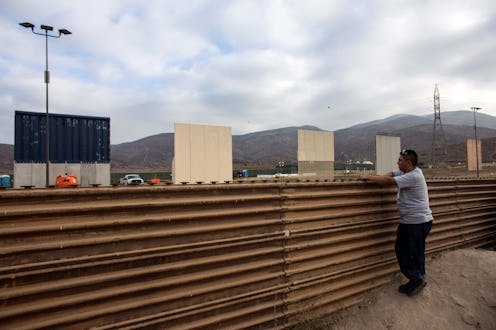News
Trump's Border Wall Prototypes Are Here & This Is What It Could Look Like

Trump's proposed border wall was perhaps the most ubiquitous element of the campaign, between the chants at Trump's rallies, the signs, and the jokes about how, exactly, Trump would force Mexico to pay for it. Actually securing funding to build that wall has proven more difficult than Trump reportedly expected, but that doesn't mean that there's been no progress. In San Diego prototypes providing glimpses of what Trump's border wall might end up looking like have already begun taking shape, a row of short but towering sections of wall to be tested and perhaps eventually expanded.
"When it comes to stopping illegal migration across our borders, border walls have proven to be an extremely effective part of our strategy," Carlos Diaz, a spokesman for Customs and Border Protection (CBP) tells Bustle. "Border walls are part of a border enforcement zone, which includes patrol roads, lights and surveillance technology. In areas where it’s needed, a border enforcement zone gives agents the best possible conditions to maintain a secure border."
CBP has had great success in cutting illegal immigration along the southern border in the past 25 years, with walls playing a significant role along certain sections of the border. While Trump's campaign speeches suggested that he wanted all wall and only wall along the border, he has since then conceded that increased border security doesn't only mean that "big, fat, beautiful wall" that he so often liked to refer to. This is in keeping with the fact that CBP's success has come from a combination of all sorts of improved security features, from increased manpower to better technology to increased cooperation with the Mexican government.
"Securing the border is not only about barriers," Diaz says. "To have operational control of our border, we also need technology and more importantly, the officers and agents who are the actual last line in the defense of our homeland."
Funding for the wall will have to come from Congress, though, and Senate Republicans will have to convince at least eight Democrats to sign on to any spending bill mandating it — a project that, so far, they have not had any success in. Democrats have repeatedly made it clear that they won't budge on the issue of funding the wall, so Trump's threats to shut down the federal government could actually come true — unlikely though that is to achieve what the president wants.
These prototypes aren't free, however. Each one has the Department of Homeland Security (DHS) spending something to the tune of $300,000 to $500,000. If each of the eight prototypes being built approaches that upper estimate, then the project will have claimed close to $4 million before testing even begins.
This funding, CBP tells Bustle, comes from the $20 million that Congress already allocated to the Department of Homeland Security for planning on the wall, although the DHS has not made public which projects of theirs are losing out on funding because of this new cost. The project went into the hands of six contractors, NPR reports, and following testing, the actual wall could use elements of any number of the prototypes. Early wall proposals took many forms, from decorated concrete to high-security mesh to a million pipe organs, but the prototypes currently under construction are half concrete and half "other materials," according to NPR.
CBP sees the investment in the prototypes as a "great" one. "It allows us to see what wall solutions are available in private sector, and the knowledge we gain from the test and evaluation phase will inform future wall designs," Diaz tells Bustle. After the wall samples are left to cure for 30 days, the testing will begin, and it will include tests of the elements that CBP requested in the proposals — for example, how well they stop people from climbing over or how difficult is to dig under them.
It's still necessary to remember, though, that throughout this whole process, experts in border security have warned that a wall, no matter how seemingly impenetrable, wouldn't be the most effective method of stopping illegal immigration. As if to prove that point, a number of migrants have already been stopped coming from Mexico just because they happened to jump over directly into the construction zone (they were stopped immediately after, though). Countries have tried to find walls in the past — but human ingenuity, when pushed to the breaking point, has always found numerous ways to scale them.
"Walls are an enduring capability that impedes and denies access in the areas where they are employed," Diaz says. As these prototypes go up and testing commences, they'll see exactly how capable these new designs are.